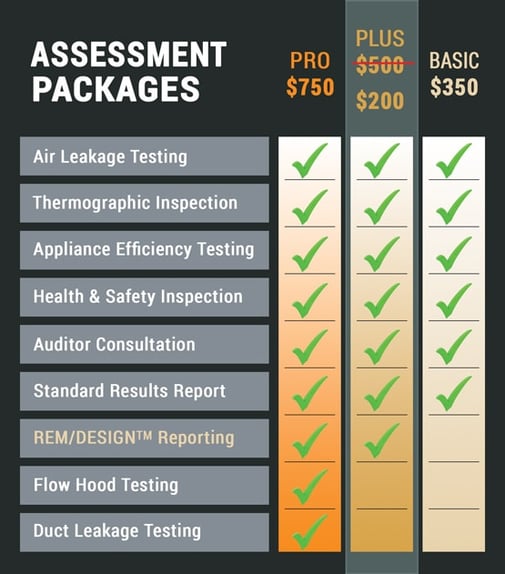The connection between energy loss and comfort—why energy testing matters more than you think
The connection between energy loss and comfort—why energy testing matters more than you think
Blog Article
Exactly How Power Screening Can Result In More Lasting Living Solutions
Power screening is an essential device for advertising sustainable living. It reveals inadequacies in energy use within homes. Techniques such as energy audits and thermal imaging give important insights. House owners can identify areas needing renovation, from insulation to home appliances. Dealing with these ineffectiveness can lead to considerable energy cost savings. Numerous stay not aware of the complete possibility of these methods. What actions can people take to boost their homes and add to a more lasting future?
Recognizing Energy Testing and Its Relevance

Typical Methods of Power Screening
There are several usual methods of energy testing that home owners can utilize to examine their power performance (air tight solutions). One commonly used method is the blower door examination, which determines the air leak in a home. By pressurizing the building, it identifies drafty areas that might require sealing. One more approach is thermal imaging, where infrared electronic cameras find temperature variants in wall surfaces, windows, and ceilings, highlighting insulation issues.Energy audits are additionally popular, including an extensive assessment of a home's power usage, frequently carried out by a professional. These audits may include evaluating home heating and cooling systems, appliances, and overall power usage patterns. In addition, clever power meters can give real-time data on energy usage, helping homeowners understand their intake habits. With each other, these techniques provide important understandings, enabling homeowners to make enlightened decisions concerning improving their energy effectiveness and advertising lasting living methods
Identifying Energy Inefficiencies in your house
Recognizing power ineffectiveness in a home is crucial for house owners aiming to decrease energy consumption and lower energy bills. Common locations to assess consist of insulation, home windows, and home appliances. Poor insulation can bring about substantial heat loss in wintertime and unwanted heat gain in summer, making heating & cooling systems work harder. Drafty windows add similarly, enabling conditioned air to leave and raising power demand.Additionally, outdated devices often eat extra power than their contemporary equivalents, even more worsening inefficiency. Homeowners must likewise take into consideration the lights system, as incandescent bulbs make use of more energy compared to LED options.Regular upkeep of a/c systems is crucial, as overlook can lead to lowered performance. By systematically reviewing these aspects of a home, home owners can determine locations requiring enhancement. Resolving these inefficiencies not only enhances convenience but additionally adds to a more sustainable way of life by reducing energy waste.
The Function of Power Audits in Sustainability
Energy audits play an essential role in promoting sustainability by offering homeowners with a considerable assessment of their power usage. These analyses determine locations where energy is wasted, allowing individuals to comprehend their usage patterns and make informed decisions for renovation. By revealing inadequacies in heating, air conditioning, insulation, and appliances, energy audits work as a crucial device for decreasing general energy demand.Furthermore, they promote the implementation of energy-saving actions, such as updating insulation or setting up energy-efficient illumination, which can significantly lower utility bills and minimize carbon footprints. The understandings acquired from an energy audit empower homeowners to prioritize sustainability in their living environments. As more homes participate in this procedure, the cumulative influence contributes to wider environmental objectives, cultivating a society of power consciousness and obligation. Ultimately, power audits are fundamental to advancing sustainable living solutions, profiting both individual house owners and the environment at large.
Innovative Technologies for Energy Effectiveness
As house owners significantly seek to boost their energy performance, ingenious innovations are arising to support these endeavors. Smart home systems, outfitted with sensors and automation, enable property owners to control and monitor power intake in real-time. These systems can change air conditioning, lights, and home heating based upon tenancy, therefore decreasing waste.In enhancement, improvements in energy-efficient devices have actually made significant strides. Tools such as ENERGY STAR-rated fridges and washing equipments eat much less energy while offering suitable performance. The integration of sustainable power sources, like solar panels and wind turbines, makes it possible for house owners to produce their very own power, lowering reliance on nonrenewable resources.Building materials have also progressed, with choices like shielded energy-efficient home windows and concrete kinds adding to decreased energy loss. With each other, these cutting-edge modern technologies not only enhance energy effectiveness however additionally cultivate a more lasting living environment, encouraging property owners to make impactful choices in their power intake methods.
Long-Term Perks of Sustainable Living
While numerous may watch lasting living as a pattern, its long-term advantages prolong far beyond plain way of life options. Embracing lasting methods results in substantial reductions in carbon impacts, contributing to a healthier planet. By reducing source usage and focusing on renewable power, people and areas can experience reduced utility expenses. This financial relief can boost economic stability with time, enabling for reinvestment in other crucial areas.Furthermore, lasting living promotes stronger area ties as people collaborate on regional campaigns, promoting social communication. Wellness advantages likewise arise, as decreased air pollution and enhanced green areas boost air quality and overall wellness. Additionally, future generations will acquire a more lasting setting, guaranteeing the schedule of natural deposits and biodiversity. Inevitably, the lasting advantages of sustainable living incorporate environmental, economic, and social measurements, presenting a compelling situation for people to official site embrace and keep these practices for the greater good.
Actions to Apply Energy-Saving Solutions
Carrying out energy-saving remedies begins with an extensive assessment of energy consumption patterns to determine areas for improvement. Once these patterns are comprehended, people can determine energy-efficient upgrades that align with their needs. Continuous monitoring and adjustments to power use assurance that these remedies continue to be effective in time.
Analyze Energy Usage Patterns

Assessing power consumption patterns is a necessary step towards identifying efficient energy-saving remedies. By systematically tracking usage across different times and individuals, companies and devices can pinpoint locations of excessive consumption. This analysis can reveal peak use durations, enabling a much better understanding of when power needs are highest possible. Furthermore, checking out patterns allows for comparisons in between comparable home appliances, highlighting those that run less efficiently. Data find more collection techniques, such as wise meters and power audits, give beneficial understandings right into overall power usage. Moreover, identifying trends in time can help in acknowledging seasonal variants and changes in intake behaviors. This foundational understanding is crucial for establishing targeted approaches that advertise lasting living and decrease overall power expenditure.
Identify Energy-Efficient Upgrades
To efficiently carry out energy-saving options, identifying energy-efficient upgrades is vital for both organizations and home owners. This process begins with a complete examination of existing systems, including heating and cooling units, insulation, and appliances. Upgrades might include installing ENERGY STAR-rated home appliances, improving insulation, and utilizing energy-efficient home windows. Additionally, implementing clever thermostats can enhance heating and cooling timetables, decreasing power usage. Shifting to LED illumination is an additional reliable measure, as it eats considerably much less energy than traditional bulbs. Furthermore, checking out renewable resource options, such as photovoltaic panels, can give lasting savings. Inevitably, prioritizing these upgrades not only contributes to lowered energy costs however likewise fosters a dedication to sustainability, benefiting both the atmosphere and future generations.
Monitor and Adjust Use
Tracking and readjusting power usage is critical for maximizing the advantages of energy-saving solutions. On a regular basis reviewing power usage patterns permits people and businesses to recognize locations for renovation. By utilizing wise meters and energy management systems, individuals can track real-time usage and discover any kind of abnormalities that might show inefficiencies.Adjusting habits, such as shutting off lights and disconnecting extra gadgets, even more boosts power financial savings. In addition, scheduling appliances to operate during off-peak hours can considerably lower costs.Conducting regular power audits guarantees that executed services stay effective in time. By actively engaging in monitoring and readjusting practices, people can maximize their power efficiency, add to sustainability efforts, and inevitably minimize their ecological impact.
Often Asked Questions
Just how much Does a Power Audit Generally Expense?

Can Energy Screening Assist Reduce Utility Bills?
Energy testing can substantially reduce energy costs by recognizing ineffectiveness in a home's power use. By resolving these problems, house owners typically experience lower usage and prices, leading to even more affordable power management and improved monetary cost savings.
What Credentials Should an Energy Auditor Have?
A power auditor ought to have appropriate qualifications, such as RESNET or BPI, along with experience in structure sciences. energy testing. Solid analytical skills and understanding of energy performance practices are necessary for carrying out exact evaluations and giving efficient referrals
Exist Federal Government Motivations for Power Efficiency Upgrades?
Government motivations for energy performance upgrades often exist, consisting of tax credit reports, refunds, and grants. These programs intend to encourage businesses and homeowners to purchase energy-saving innovations, inevitably advertising environmental sustainability and lowering overall power consumption.
How Often Should I Conduct Power Testing in My Home?
Power screening should ideally be conducted annually to identify ineffectiveness. Property owners may take into consideration a lot website here more frequent evaluations after significant renovations, adjustments in energy costs, or if uncommon drafts or temperature level variants are seen within the home. Energy testing makes it possible for the evaluation of exactly how well a home makes use of energy, identifying areas where waste takes place. Identifying power inadequacies in a home is crucial for house owners aiming to reduce power usage and lower utility bills. Power audits play a necessary duty in promoting sustainability by supplying property owners with an extensive analysis of their energy usage. By revealing inadequacies in home heating, air conditioning, insulation, and home appliances, energy audits serve as a critical tool for lowering general power demand.Furthermore, they facilitate the execution of energy-saving measures, such as updating insulation or mounting energy-efficient illumination, which can significantly decrease energy bills and lower carbon impacts. Power screening can noticeably lower energy expenses by recognizing inadequacies in a home's power use.
Report this page